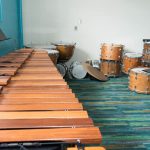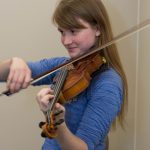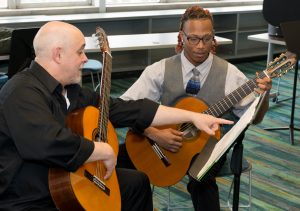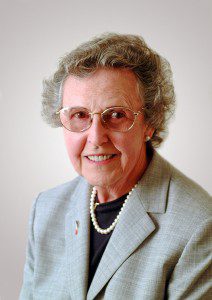WESTFIELD – Westfield State University art, music and theatre staff and students are enjoying being under the same roof at the Catherine Dower Performing and Fine Arts Center in the former Juniper Park elementary school.
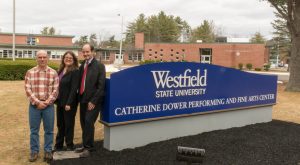
(L-R) Professor David Shapleigh, chair of the Art Department, Dr. Sabine Macris Klein, Theatre Arts program coordinator and Dr. Andrew Bonacci, head of the Music Department in front of the Catherine Dower Performing and Fine Arts Center, in the former Juniper Park Elementary School. (All photos by Lynn Boscher)
The center opened its doors in January after $5.8 million in upgrades. Curt Robie, project manager, who retired in December as associate vice president in Capital Planning, stayed on to finish the project. Robie said no additions were made to the building itself, which remains as designed in 1968. What has transformed is space to make art.
Dr. Andrew Bonacci, chair of the Music Department, spoke about moving the department over from Bates Hall, an old science building, which Bonacci referred to as “adequate.”
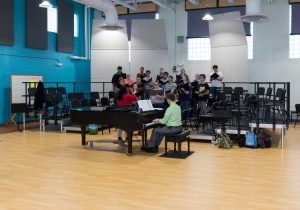
Shared rehearsal space in the old Juniper Park gymnasium. State of the art acoustical banner treatments on windows are raised for chorale, lowered for music.
“Now we have this lovely, acoustical rehearsal space,” Bonacci said, opening the doors to the old Juniper Park gymnasium where the University Chorale was practicing. “It’s been transformed,” he said.
Bonacci said they have state of the art acoustical banners in the room, which can be brought down for music, and up for chorus, for resonance. He added that he tried to get Robie to leave a basketball hoop in the room, but he wouldn’t.
Most performances still take place on the Dever stage, although there is a shared performance space in the Dower Center. Robie said that large performance venues and an elevator are in the future for the Center, too. “$35 to $40 million in the future,” he said.
Right outside the door of the rehearsal space is the percussion studio. Bonacci said they were able to eliminate the adjoining problems that they had in Bates, where they had to leave an empty practice room in between ones that were being used. In the Dower Center, the brick work with no pipes allows percussionists to practice while the rehearsal space is being used. “There are no sound problems,” Bonacci said.
“That’s another wonderful thing about being over here. With the design, things are separated very nicely,” Bonacci added.
The soundproof practice rooms on the second floor of the new center have state of the art Virtual Acoustic Environment (VAE) technology manufactured by Winge Corp in Wisconsin. “This is what has really transformed the experience for students, “Bonacci said. Using the VAE, the same technology used in Boston Symphony Hall, they can acoustically engineer the room to sound like an arena or a cathedral. They can also record themselves.
“It makes Bach more fun,” said sophomore Veronica Rovatti, a violin major from Feeding Hills who was practicing in one of the rooms.
In a classical guitar classroom, Professor John Mason was working on a piece with several students. Asked what they thought of their new building, Mason said, “The heat’s better, the windows are great. It’s a big step up.”
“I actually like it. It’s better than Bates. Having the music and arts department (together) feels more homey,” agreed senior TyShaun Davis of Springfield.
The three department chairs indeed have their offices right next to each other in the central corridor, the old teacher’s lounge. They also share computer labs, an electronic sound studio, still in progress; and a student lounge in the former nurse’s office.
Professor David Shapleigh, chair of the Art Department said Westfield is now the only state university that has music and art and theatre majors housed in one facility. The effect has led to collaboration among the departments. Dr. Sabine Macris Klein, Theatre Arts program coordinator says she has music or art students stop by and ask her about theatre, something which didn’t happen before.
Shapleigh thought about adding music to a mini art show. He talked to Bonacci, and now has a small ensemble which will be playing during the show. “There’s been discussion with our animation classes, of having a musical score. Talk of pairing up students,” Shapleigh added.
“Just getting all the students from the three programs under one roof, in the same classrooms, making art,” Bonacci said.
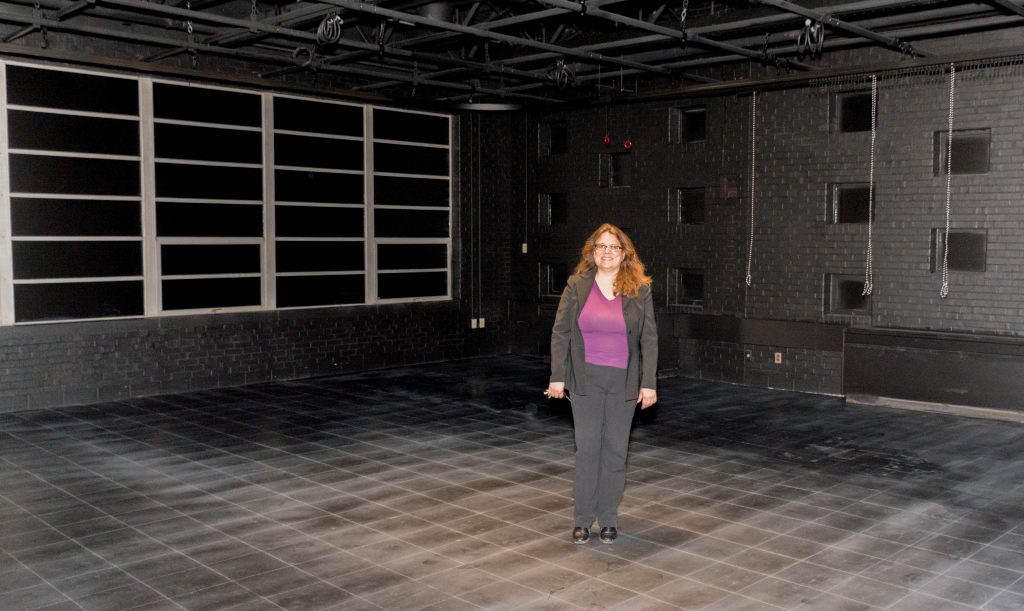
Dr. Sabine Macris Klein, Theatre Arts program coordinator, in lighting room in the Theatre Arts department. Students practice different lighting techniques, and acting and directing classes are taught in the room, part of the former cafeteria in Juniper Park.
The Theatre wing is smaller than the other wings. The Music department has 85 majors. Art has 90 undergraduate majors and 66 graphic design minors, according to Shapleigh. Theatre Arts, which is a major in the English department, has 25 to 30 students majoring in it. Klein said theatre is also among the general classes that all students take.
In the Dower Center, the theatre department is in the old cafeteria. The main room is a performance and practice space. A part of the cafeteria has been divided into a lighting studio with black tiles and dozens of lights overhead to practice lighting techniques. They also hold acting and directing classes in the room.
There is also a state of the art sound room for sound design, which is shared by the other departments, and computers with multiple programs to work on Scenography, the sampling of all designs together, sound, set, costume and lighting.
The art department moved over from Parenzo Hall, where it occupied three floors at the end of the building, including the basement. Graphic Arts Professor Jamie Wainright said the studio space were old science classrooms which had gas burners that couldn’t be moved.
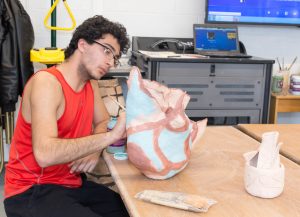
Senior Christian Capalbo, a double art and geography/regional planning major, working in the pottery studio.
In the Catherine Dower Performing and Fine Arts Center, the art wing is on two floors, opposite the music wing. There are pottery, sculpture, painting and drawing studios and a Mac lab.
In the pottery studio, students were working on hand-built pieces. Junior Christian Capalbo, a member of the Student Government Association, said it took a little while to get everything situated the way they wanted it.
“A lot of cool things are being made here. There are a lot of submissions for studio art shows in late April,” Capalbo said. He said the pottery and sculpture studio used to be in the basement in Parenzo. “The lighting is great, having the windows open all the time,” he added.
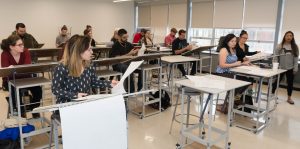
Drawing class in Catherine Dower Performing and Fine Arts Center. “It’s been a great transition for everyone. The lighting itself, and more studio spaces,” said drawing teacher Susan Montgomery.
Professor Keith Hollingworth, who teaches color theory, sculpture, and drawing, said his office used to be in the basement. “Sculpture was in the basement with ceramics. It was like being in the dungeon. I had an office in the basement with no windows,” Hollingworth said.
Hollingworth also talked about the change in atmosphere from Parenzo Hall. “In Parenzo, because there were other departments and offices in the building, there was always this energy, this coming and going. That doesn’t happen here. Having a single wing, the second floor is quiet and peaceful. This is one of the adjustments students are making. Now they have the chance to really focus. I think it’s a very positive thing. Art activity is something you do alone,” he explained.
Shapleigh said it is a 100% improvement, being in the proper space. “How the students view themselves as artists is rising,” he added.
Catherine Dower, Ph.D., professor emerita of music history and literature, was a philanthropist who donated $1 million to the University, the largest single gift in its history, to establish the Catherine Dower Performing and Fine Arts Center. Dower passed away in February, shortly after the center opened its doors on January 23.
There will be a Celebration of Life event to honor the late Dr. Catherine Dower on May 11 at 2:30 p.m. at the Catherine Dower Performing and Fine Arts Center. The building will open earlier at 1 p.m., at which time light refreshments will be served and memorabilia from throughout Dr. Dower’s life and her impact on the university’s Music Department will be on display.

